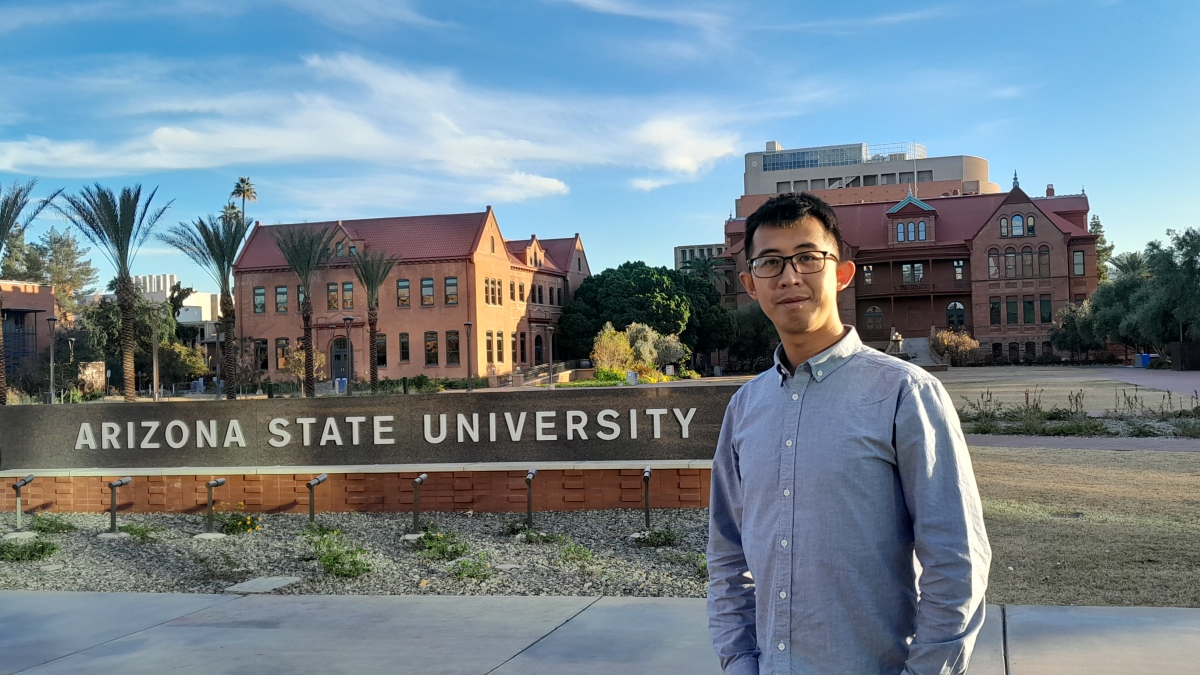New ASU professor seeks to advance quantum sensing research

Assistant Professor Mouzhe Xie joined ASU’s School of Molecular Sciences this semester. He brings with him a diverse skill set that includes expertise in biology, chemistry, engineering, physics and quantum information sciences.
Nuclear magnetic resonance, or NMR, is an important spectroscopy and imaging method in research that can be used to study the structure and dynamics of molecules, and to visualize tissue and structures in the human body without damaging them.
The technique is better known in the medical field as magnetic resonance imaging (MRI), where a patient is moved into the bore of a large magnet on a table. Nanoscale NMR improves sensitivity and scope by several orders of magnitude over conventional NMR.
At Arizona State University, Assistant Professor Mouzhe Xie is hard at work in his lab building a nanoscale NMR device — something that could reshape the landscape of health care for the better.
“It's still early stages, but I want to emphasize the kind of general capability of this technology,” Xie said. “We can literally use it to study any biological system on the molecular or cellular level.”
Xie, who joined ASU’s School of Molecular Sciences this semester, brought with him a diverse skill set that includes expertise in biology, chemistry, engineering, physics and quantum information sciences. His academic experience includes postdoctoral research in the laboratory of Peter Maurer, first at École polytechnique fédérale de Lausanne (EPFL), Switzerland, and later at the Pritzker School of Molecular Engineering at the University of Chicago, where Xie expanded his expertise in NMR and biophysics.
Xie has worked on diamond-based quantum-sensing technology for chemical and biological applications, and he has also worked extensively on diamond material engineering. The integration of these technologies has the potential to lead to novel sensing platforms for molecular analytics, drug discovery and disease diagnosis.
The second quantum revolution
As a field of study that won the Nobel Prize in physics 2022, quantum information sciences (QIS) evolved over about the last 20 years as part of what has been called the second quantum revolution. Scientists can now engineer a quantum system and then use it to perform exciting new research. Examples abound in quantum computing, quantum informatics and quantum sensing. Nanoscale NMR is one of many examples of quantum sensing.
Nitrogen-vacancy (NV) centers, a type of point defect in diamond, which gives pink diamonds their color, are prized for their long coherence times at room temperature and the easy readability of their quantum states. The defects stand out not only in quantum information but as tiny magnetometers, the basis for nanoscale NMR. NV centers implanted a few nanometers below a diamond surface can detect the presence and chemical identity of molecules, even down to the single molecule regime.
“The basic principle of detecting weak magnetic fields generated by nuclear spins remains the same with nanoscale NMR, but instead of using the metal coil, which you see in a conventional NMR spectrometer, we use the so-called quantum sensor,” Xie explained. “This relies on the NV defect in diamond crystal. We can optically read out the magnetic signal by counting how many photons the fluorescent NV defect emit, instead of measuring the current in the coil.”
One of the reasons Xie joined ASU is to collaborate with experts in diamond research groups, including ASU Regents Professor Robert Nemanich in the Department of Physics, to make high-quality, specialized single-crystal diamonds with nitrogen-vacancy centers in a controlled fashion.
Xie is in the process of merging several scientific fields.
“If you talk to a physicist, they might feel a little bit limited in terms of functionalizing diamond materials or working on a single cell or protein expression,” he said. “On the other hand, if you talk to a biologist, they might feel uncomfortable writing down the Hamiltonian of a quantum system.”
Xie is able to bridge all of this knowledge and hopefully take advantage of what people have already explored and established in their own subfields.
“I hope to explore uncharted scientific territories by bringing knowledge together and implementing it in a comprehensive way,” he said.
More University news

Miki Kittilson appointed dean of ASU's College of Global Futures
Miki Kittilson has been appointed dean of Arizona State University’s College of Global Futures, a unit of the Julie Ann Wrigley Global Futures Laboratory.“As we enter this next phase of…
Graduate College celebrates 2024–25 Outstanding Faculty Mentors
Each year, Arizona State University’s Graduate College celebrates faculty members who have demonstrated an unwavering commitment to mentoring and supporting graduate students and postdoctoral…

ASU's building boom illustrates university's commitment to keep moving forward
To understand how Arizona State University is never settling and constantly improving, look up.At the seven-story student housing complex being built near Mill Avenue in Tempe.At the…

